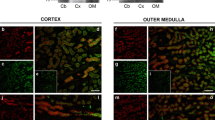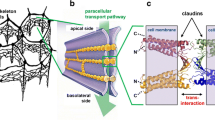Abstract
The distal convoluted tubule (DCT) from rabbit kidney were perfused in vitro to study the conductive properties of the cell membranes by using electrophysiological methods. When the lumen and the bath were perfused with a biearbonate free solution buffered with HEPES, the transepithelial voltage (V T) averaged −2.8±0.6 mV (n=20), lumen negative. The basolateral membrane voltage (V B) averaged −77.8±1.1 mV (n=33) obtained by intracellular impalement of microelectrodes. Cable analysis performed by injecting a current from perfusion pipette revealed that the transepithelial resistance was 21.8±1.7 Ω·cm2 and the fractional resistance of the luminal membrane was 0.78±0.03 (n=8), indicating the existence of ionic conductances in the luminal membrane. Addition of amiloride (10−5 mol/l) to the luminal perfusate or Na+ removal from the lumen abolished the lumen negativeV T and hyperpolarized the apical membrane. An increase in luminal K+ concentration from 5 to 50 mmol/l reduced the apical membrane potential (V A) by 37.5±2.6 mV (n=7), whereas a reduction of Cl− in the luminal perfusate did not changeV A significantly (0.5±0.5 mV,n=4). Addition of Ba2+ to the lumen reducedV A by 42.6±1.0 mV (n=4). When the bathing fluid was perfused with 50 mmol/l K+ solution, the basolateral membrane voltage (V B) fell from −76.8±1.5 to −31.0±1.3 mV (n=18), and addition of Ba2+ to the bath reducedV B by 18.3±4.8 mV (n=7). Although a reduction of Cl− in the bathing fluid from 143 to 5 mmol/l did not cause any significant fast initial depolarization (1.8±1.7 mV,n=8), a spike like depolarization (14.0±2.5 mV,n=4) was observed, upon Cl− reduction in the presence of Ba2+ in the bath. From these results, we conclude that the apical membrane of DCT has both K+ and Na+ conductances and the basolateral membrane has a K+ conductance and a small Cl− conductance.
Similar content being viewed by others
References
Burg M, Grantham J, Abramow M, Orloff J (1966) Preparation and study of fragments of single rabbit nephron. Am J Physiol 210:1293–1298
Burg MB (1986) Renal handling of sodium, chloride, water, amino acids, and glucose. In: Brenner BM, Rector Jr FC (eds) The kidney, 3rd edn. Saunders, Philadelphia, pp 328–370
Cook DI, Frömter E (1985) Is the voltage divider ratio a reliable estimate of the resistance ratio of the cell membranes in tubular epithelia? Pflügers Arch 403:388–395
Costanzo LS, Windhager E (1986) Transport functions of the distal convoluted tubule. In: Andreoli TE, Hoffman JF, Fanestil DD, Schultz SG (eds) Physiology of membrane disorders. Plenum Medical Book Company. New York London, pp 727–750
Ellison DH, Velázquez H, Wright FS (1985) Stimulation of distal potassium secretion by low lumen chloride in the presence of barium. Am J Physiol 248:F638-F649
Ellison DH, Velázquez H, Wright FS (1986) Unidirectional potassium fluxes in renal distal tubule: effects of chloride and barium. Am J Physiol 250:F885-F849
Ellison DH, Velázquez H, Wright FS (1987) Thiazide-sensitive sodium chloride cotransport in early distal tubule. Am J Physiol 253:F546-F554
Frömter E (1986) The electrophysiological analysis of tubular transport. Kidney Int 30:216–228
Good DW, Wright FS (1979) Luminal influences on potassium secretion, sodium concentration and fluid flow rate. Am J Physiol 236:F192-F205
Good DW, Wright FS (1980) Luminal influences on potassium secretion: transepithelial voltage. Am J Physiol 239:F289-F298
Good DW, Velázquez H, Wright FS (1984) Luminal influences on potassium secretion: low sodium concentration. Am J Physiol 246:F609-F619
Greger R (1981) Cation selectivity of the isolated perfused cortical thick ascending limb of Henle's loop of rabbit kidney. Pflügers Arch 390:30–37
Gross JB, Imai M, Kokko JP (1975) A functional comparison of the cortical collecting tubule and the distal convoluted tubule. J Clip Invest 55:1284–1294
Hierholzer K (1985) Sodium reabsorption in the distal tubular system. In: Seldin DW, Giebisch G (eds) The kidney: physiology and pathophysiology. Raven Press, New York, pp 1063–1096
Imai M (1979) The connecting tubule: a functional subdivision of the rabbit distal nephron segments. Kidney Int 15:346–356
Imai M, Nakamura R (1982) Function of distal convoluted and connecting tubules studies by isolated nephron fragments. Kidney Int 22:465–472
Kaissling B, Kriz W (1979) Structural analysis of the rabbit kidney. Adv Anat Embryol Cell Biol 56:1–123
Kaissling B, Kriz W (1982) Structural aspects of adaptive changes in renal electrolyte excretion. Am J Physiol 243:F211-F226
Koeppen BM, Biagi BA, Giebisch G (1983) Intracellular microelectrode characterization of the rabbit cortical collecting duct. Am J Physiol 244:F35-F47
Kriz W, Kaissling B (1985) Structural organization of the mammalian kidney. In: Seldin DW, Giebisch G (eds) The kidney: physiology and pathophysiology, Raven Press, New York, pp 265–305
Malnic G, Giebisch G (1972) Some electrical properties of distal tubular epithelium in the rat. Am J Physiol 223:797–808
Malnic G, Klose RM, Giebisch G (1966) Micropuncture study of distal tubular potassium and sodium transport in rat nepron. Am J Physiol 211:529–547
Malnic G, Klose RM, Giebisch G (1966) Micropuncture study of distal tubular potassium and sodium transfer in rat kidney. Am J Physiol 211:548–559
Sansom SC, O'Neil RG (1985) Mineralocorticoid regulation of apical cell membrane Na+ and K+ transport of the cortical collecting duct. Am J Physiol 248:F858-F868
Sansom SC, O'Neil RG (1986) Effects of mineralocorticoids on transport properties of cortical collecting duct basolateral membrane. Am J Physiol 211:F743-F757
Schnermann J, Sreipe B, Briggs JP (1987) In situ studies of distal convoluted tubule in rat. II. K secretion. Am J Physiol 252:F970-F976
Shareghi GR, Stoner LC (1978) Calcium transport across segments of the rabbit distal nephron in vitro. Am J Physiol 235:F367-F375
Shimizu T, Yoshitomi K, Nakamura M, Imai M (1988) Site and mechanism of action of trichlormethiazide in rabbit distal nephron segments perfused in vitro. J Clin Invest 82:721–730
Shimizu T, Yoshitomi K, Taniguchi J, Imai M (1989) Effect of high NaCl intake on Na+ and K+ transport in rabbit distal convoluted tubule. Pflügers Arch (in press)
Taniguchi J, Yoshitomi K, Imai M (1989) K+ channel currents in basolateral membrane of distal convoluted tubule of rabbit kidney. Am J Physiol 256:F246-F254
Velázquez H, Greger R (1985) K & Cl permeabilities in cells of rabbit early distal convoluted tubule. Kidney Int 27:322 (Abstr)
Velázquez H, Greger R (1986) Influences on basolateral K conductance of cells of early distal convoluted tubule. Kidney Int 31:409 (Abstr)
Velázquez H, Wright FS (1986) Effects of diuretic drugs on Na, Cl, and K transport by rat renal distal tubule. Am J Physiol 250:F1013-F1023
Velázquez H, Wright FS, Good DW (1982) Luminal influences on potassium secretion: chloride replacement with sulfate. Am J Physiol 242:F46-F51
Velázquez H, Good DW, Wright FS (1984) Mutual dependence of sodium and chloride absorption by renal distal tubule. Am J Physiol 247:F904-F911
Velázquez H, Ellison DH, Wright FS (1987) Chloride-dependent potassium secretion in early and late distal tubules. Am J Physiol 253:F555-F562
Velázquez H, Ellison DH, Wright FS (1988) Multiple pathways for potassium transport across basolateral membrane of rabbit distal convoluted tubule cell. Kidney Int 33:429 (Abstr)
Wright FS, Giebisch G (1985) Regulation of potassium excretion. In: Seldin DW, Giebisch G (eds) The kidney; physiology and pathophysiology. Raven Press, New York, pp 1223–1250
Yoshitomi K, Koseki C, Taniguchi J, Imai M (1987) Functional heterogeneity in the hamster medullary thick ascending limb of Henle's loop. Pflügers Arch 408:600–608
Author information
Authors and Affiliations
Rights and permissions
About this article
Cite this article
Yoshitomi, K., Shimizu, T., Taniguchi, J. et al. Electrophysiological characterization of rabbit distal convoluted tubule cell. Pflugers Arch. 414, 457–463 (1989). https://doi.org/10.1007/BF00585057
Received:
Revised:
Accepted:
Issue Date:
DOI: https://doi.org/10.1007/BF00585057




